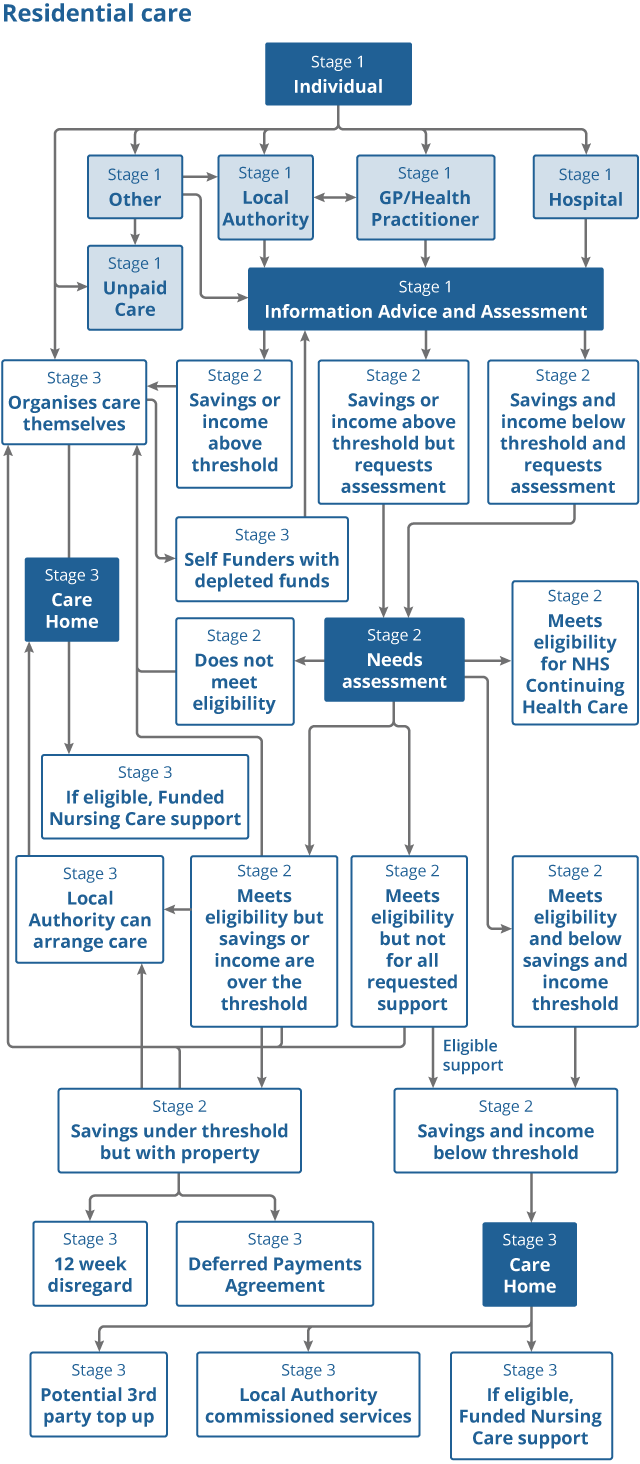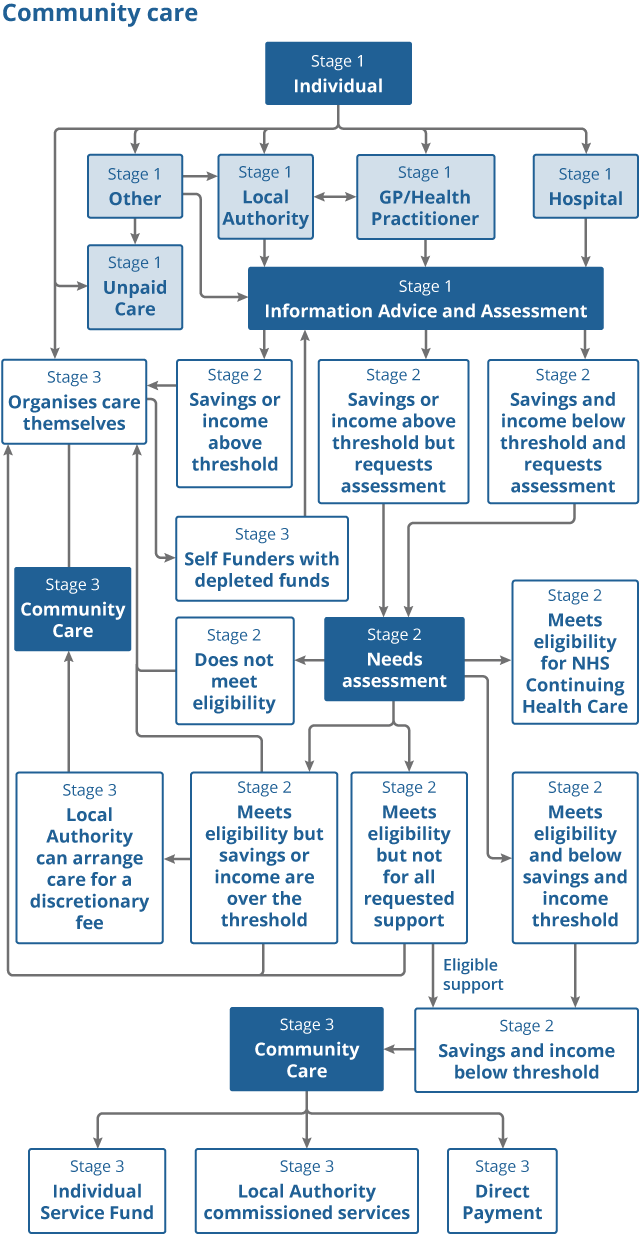Table of contents
- Overview of Care Pathway Models
- Residential and Community Care Pathway Models
- Stage 1: Getting information on accessing social care and funding support
- Stage 2: Assessing if an individual is eligible for care through the local authority
- Stage 3: Determining how the care is funded and organised
- Feedback
- Related links
1. Overview of Care Pathway Models
The Office for Statistics Regulation report on Adult Social Care Statistics in England highlighted several aspects of adult social care where there is a lack of official information and statistics, for example, on the pathways and transitions into and out of adult social care, and the value of privately funded care.
There are many ways an individual can access social care in England. Residential care is care provided in a care home, while community care is provided in an individual’s own home. There are also differences in how care is funded.
A self-funder is typically an individual who organises or funds their own care in residential or community settings, as opposed to receiving financial support from the local authority or another third party (state-funded). To help understand the different pathways into adult social care in England, we have created two Care Pathway Models (see Figures 1 and 2) to demonstrate the routes into residential and community care and the various funding options available.
We have created separate residential and community models to aid user understanding and highlight the differences between them in relation to social care funding. The models provide a high-level overview of the pathways into care as of 15 October 2021; more detail can be found in the Care Act 2014. These models are an updated version of, and replacement for, the Care Pathway Model as featured in our blog Social care: Estimating the size of the self-funding population.
Back to table of contents2. Residential and Community Care Pathway Models
Figure 1: Flow diagram of funding routes for residential care in England

Source: Office for National Statistics – Care Pathway Model
Notes:
- For additional explanation of terms used in this flow chart, please refer to descriptions in Section 3: Description of the pathways into residential or community care.
Download this image Figure 1: Flow diagram of funding routes for residential care in England
.png (150.4 kB)
Figure 2: Flow diagram of funding routes for community care in England

Source: Office for National Statistics – Care Pathway Model
Notes:
- For additional explanation of terms used in this flow chart, please refer to descriptions in Section 3: Description of the pathways into residential or community care.
Download this image Figure 2: Flow diagram of funding routes for community care in England
.png (129.9 kB)Figures 1 and 2 show the pathways an individual can take to access residential or community care in England, and the funding options available to them. There are three main stages represented in the Care Pathway Models:
- stage 1: getting information on accessing social care and funding support
- stage 2: assessing if an individual is eligible for care through the local authority or NHS Continuing Health Care
- stage 3: determining how the care will be funded
These stages are explained in more detail in the following sections.
Back to table of contents5. Stage 3: Determining how the care is funded and organised
Self-funding care
Where a self-funder contacts their local authority and has property that is taken into account when deciding funding eligibility, the property will be disregarded for 12 weeks and care funded by the local authority. This is so that the individual can organise how they will use the property to self-fund their care (for example, sell the property or let the property).
After 12 weeks, or after the date of the sale of the property if before 12 weeks, the individual would be expected to self-fund their care; this is known as the 12-week disregard. This applies to residential care only as the value of a property is not taken into account for community care. This also only applies to individuals who undergo a financial assessment as part of the local authority assessment.
Funding can then be organised for:
- those who have contacted the care provider directly
- those who have contacted their local authority but are not eligible for 12-week disregard
- those who have contacted their local authority and following the 12-week disregard
The care can be organised in one of the following three ways:
- self-funder organises their own care
- the local authority organises services
- deferred payment agreement
Self-funder organises own care
For an individual over the income or savings threshold and not eligible for NHS continuing health care, they can organise and pay for their care with no involvement of the local authority. This applies to both residential and community care.
Local authority organises services
For an individual over the income and savings threshold and not eligible for NHS continuing health care, but who meets eligibility for care from the needs assessment, the local authority can arrange their care. This is paid for by the individual (a discretionary fee can be charged for arranging care in the community). This applies to both residential and community care.
Deferred payment agreement
Where property is taken into account in funding eligibility, an individual may enter a legal agreement with the local authority where the local authority would pay for their care, and the individual repays this on sale of their property. This can be arranged after a 12-week disregard and applies to residential care only as property is not taken into account for community care.
State-funded care
Care can be organised using the following methods for state-funded recipients of care:
- local authority commissioned services
- third-party top-up
- direct payment
- individual service fund
Local authority commissioned services
The local authority arranges for care and support to be provided for the individual, and the local authority will pay a contribution towards, or sometimes the full amount, for the care and support. This applies to residential and community care.
Third-party top-up
If the individual decides to choose a home that is more expensive than the budget set by the local authority, they can arrange for a third-party top-up, whereby the extra amount is paid by a third party. This applies to residential care only.
Direct payment
A set amount of money (personal budget), based on the needs assessment, is paid directly to the individual or an authorised person (if the individual does not have capacity to request the direct payment), for them to arrange their own care; for example, via a personal assistant. This applies to community care only.
Individual service fund
This is where an individual chooses a provider, rather than the council or themselves, to manage their personal budget (based on the outcome of the needs assessment). This applies to community care only.
Deciding on the individual’s personal budget
In the case of state-funded individuals, the local authority’s decision on the personal budget must account for the individual’s desired outcomes and preferences. This is as well as considering value for money, affordability, and the promotion of the individual’s well-being. As outlined in the Care Act 2014, these decisions are part of the care and support needs planning process and are distinct from the needs assessment and eligibility determination.
For residential care, this is relatively straightforward; the main option is local authority commissioned services, and if an individual seeks care and support in addition to what is deemed sufficient by the local authority, then this can be met through a third-party top-up. These decisions may be more complex for community care and depend on the precise situation; for example, the number of hours of cleaning to fund if an individual cannot ensure their home is sufficiently clean to be safe, or the level of assistance with cooking meals if someone is unable to cook for themselves.
Back to table of contents6. Feedback
To help improve and develop our Care Pathway Models, we are interested in receiving feedback from users. We would like to know:
- To what extent have the Care Pathway Models helped to inform your understanding of the social care system?
- What elements, if any, of the Care Pathway Models would you like to be improved to improve understanding of the social care system?
If you have any thoughts on the above questions, or if you would like to engage with us further about this piece of work, we welcome any feedback, comments and suggestions by email to social.care@ons.gov.uk.
Back to table of contents